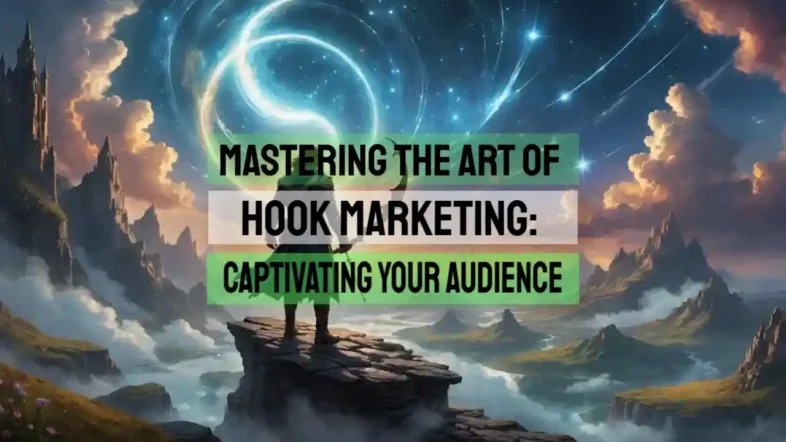In the world of content marketing, hook marketing is capturing the attention of your readers with your first impression. It’s the element that draws in your audience and keeps them reading.
For small business owners and marketing professionals, crafting an effective hook can be the difference between a potential client engaging with your content or moving on to a competitor.
This wide-ranging guide will delve into the nuances of creating hooks that not only captivate but also offer tangible value to your audience.
Why Should Your Audience Bother Reading?
The primary purpose of a hook is to answer the question: “Why should I care?” Your audience is bombarded with content daily, so you need to immediately convey the value they will gain. A strong hook promises solutions, insights, or valuable information that is relevant to their needs.
How the Hook Can Help Solve a Problem
Every piece of content should aim to solve a problem for the reader. By identifying common pain points experienced by small business owners and marketers, you can craft hooks that speak directly to their challenges. For instance, if time management is a common issue, a hook like, “Discover the top three time-saving tools every small business owner needs,” immediately signals a solution.
What Will They Learn?
Let your audience know what they stand to gain from investing their time in your content. Specificity is key. For example, “Learn how to increase your website traffic by 50% in just 30 days,” provides a clear and enticing outcome that draws the reader in.
Actionable Tips for Crafting Effective Hooks
Poke at Pain Points
Identify and address the specific challenges your audience faces. For example, “Struggling to convert leads into customers? Here's what you’re missing,” speaks directly to a common frustration.
Add Credibility with Quantifiable Proof
Incorporate statistics, case studies, or testimonials. A hook like, “How we helped a small business increase sales by 120% in six months,” adds credibility and piques interest.
Get Specific with Outcomes
Be precise about what the reader will achieve. Vague promises are less compelling. For instance, “Boost your email open rates by 30% with these three strategies,” offers a clear and measurable benefit.
Leave a Cliffhanger
Intrigue your audience by hinting at valuable content they will only discover by reading further. For example, “The one marketing tactic that doubled our leads overnight – and you’re probably not using it.”
Case Study: Effective Hooks in Action
Consider the case of a small business consulting firm that struggled with low engagement on their blog. By implementing hooks that addressed specific pain points, such as “5 Mistakes Small Business Owners Make on Social Media” and “How to Triple Your ROI with These Simple Marketing Tweaks,” they saw a 40% increase in readership over three months.
Data and Research Supporting Effective Hooks
Research by Copyblogger suggests that 80% of readers never make it past the headline. This statistic underscores the importance of a compelling hook. Additionally, studies have shown that content with specific, outcome-oriented hooks is more likely to be shared and engaged with.
Step-by-Step Process for Crafting Your Own Hooks
1. Identify your audience's primary pain points. 2. Craft a statement that addresses these issues directly. 3. Incorporate quantifiable proof or specific outcomes. 4. Keep it concise and intriguing. 5. Test different hooks to see which resonates best with your audience.
By following these steps, you'll be well on your way to creating hooks that not only capture attention but also drive engagement and conversions.
Inspiring Journeys of Successful Lifestyle Entrepreneurs
The allure of financial independence and a balanced lifestyle has given rise to a new breed of entrepreneurs: lifestyle entrepreneurs. These individuals have harnessed the power of digital platforms, passive income, and innovative business models to build thriving businesses on their own terms. This article will showcase some of the most successful lifestyle entrepreneurs, detailing their journeys, strategies, and the tools they used to succeed.
Leveraging Digital Platforms
Successful lifestyle entrepreneurs often leverage digital platforms to reach a global audience. For example, Pat Flynn of Smart Passive Income built his brand by sharing his journey and strategies for generating passive income. By using platforms like podcasts, blogs, and YouTube, Flynn has created a multi-million dollar business that allows him to work on his terms.
Passive Income Strategies
Passive income is a cornerstone of the lifestyle entrepreneur's strategy. Entrepreneurs like Michelle Schroeder-Gardner of Making Sense of Cents have mastered this by creating online courses, affiliate marketing, and investing in real estate. Schroeder-Gardner’s blog, which started as a side hustle, now generates over $100,000 per month, allowing her to travel full-time.
Innovative Business Models
Innovative business models are another key to their success. Tim Ferriss, author of “The 4-Hour Workweek,” popularized the idea of outsourcing and automation to free up time for personal pursuits. His approach has inspired countless entrepreneurs to rethink traditional business models and prioritize efficiency and flexibility.
The Importance of Personal Branding
Personal branding is crucial for lifestyle entrepreneurs. Marie Forleo, founder of B-School, has built a personal brand that emphasizes authenticity and empowerment. Her strong personal brand has attracted a loyal following and positioned her as a leading voice in online business education.
Time Management and Work-Life Balance
Time management and work-life balance are essential components of a successful lifestyle business. Entrepreneurs like Chris Guillebeau, author of “The $100 Startup,” emphasize the importance of setting boundaries and prioritizing activities that align with personal values and goals. Guillebeau’s approach has enabled him to visit every country in the world while running his business.
Actionable Insights for Aspiring Lifestyle Entrepreneurs
Define Your Brand
Determine what sets you apart and communicate that consistently across all platforms. A strong personal brand will attract your ideal audience and differentiate you from competitors.
Create Multiple Income Streams
Diversify your income sources to ensure financial stability. Consider affiliate marketing, online courses, and investments as potential revenue streams.
Prioritize Time Management
Use tools and techniques to manage your time effectively. This could include outsourcing tasks, automating processes, and setting clear boundaries between work and personal time.
Case Studies: Diverse Paths to Success
Consider the journey of John Lee Dumas, host of the “Entrepreneurs on Fire” podcast. By focusing on daily interviews with successful entrepreneurs, Dumas has built a seven-figure business. Similarly, Natalie Sisson, the “Suitcase Entrepreneur,” has created a successful online business that allows her to work from anywhere in the world.
Data and Research Supporting Lifestyle Entrepreneurship
According to a report by the Global Entrepreneurship Monitor, lifestyle entrepreneurship is on the rise, with more people seeking flexible work arrangements. Additionally, a study by FlexJobs found that 70% of workers believe that work-life balance is a critical factor in their career decisions.
Practical Steps to Start Your Journey
1. Identify your passions and strengths. 2. Build a personal brand around your unique value proposition. 3. Develop multiple income streams. 4. Leverage digital platforms to reach a wider audience. 5. Prioritize time management and work-life balance. 6. Continuously learn and adapt to new trends and technologies.
By following these steps and learning from the success stories of established lifestyle entrepreneurs, you can embark on your journey towards financial independence and a balanced, fulfilling lifestyle.
Read More Practical advice on making money:



